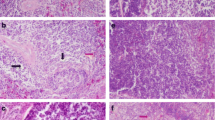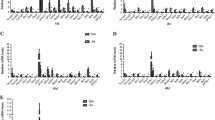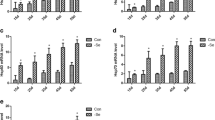Abstract
Despite increasing evidence indicating the essential involvement of selenium (Se) in the immune system, the effect of Se deficiency on the regulation of oxidative stress and heat shock proteins (Hsps) in broiler chickens is still unclear. In the present study, we established an exudative diathesis (ED) broiler chicken model caused by Se deficiency. We then analyzed histological observations and detected the expression levels of Hsps and antioxidant indexes in immune tissues. The antioxidant function declined remarkably, and most of the Hsp expression levels increased significantly in the spleen, thymus, and bursa of Fabricius of the broiler chicks with ED (except the messenger RNA (mRNA) levels of Hsp27, Hsp40, and Hsp70, which decreased in thymus tissues from the treatment groups); therefore, constitutive oxidation resistance and higher Hsps in broiler chicks with ED caused defects in immune organ morphology and function, as evidenced by abnormal histological structures: red pulp broadening and lymphocytes in the cortex and medulla of the thymic lobule decreased distinctly and distributed loosely. These results underscore the importance of Se in establishing an immune organ microenvironment conducive to normal function.





Similar content being viewed by others
References
Lenz M, Lens PN (2009) The essential toxin: the changing perception of selenium in environmental sciences. Sci Total Environ 407(12):3620–3633. doi:10.1016/j.scitotenv.2008.07.056
Ruan H, Zhang Z, Wu Q, Yao H, Li J, Li S, Xu S (2012) Selenium regulates gene expression of selenoprotein W in chicken skeletal muscle system. Biol Trace Elem Res 145(1):59–65. doi:10.1007/s12011-011-9166-y
Kiremidjian-Schumacher L, Roy M, Wishe HI, Cohen MW, Stotzky G (1992) Regulation of cellular immune responses by selenium. Biol Trace Elem Res 33:23–35
Estevez AO, Mueller CL, Morgan KL, Szewczyk NJ, Teece L, Miranda-Vizuete A, Estevez M (2012) Selenium induces cholinergic motor neuron degeneration in Caenorhabditis elegans. Neurotoxicology 33(5):1021–1032. doi:10.1016/j.neuro.2012.04.019
Zhao X, Yao H, Fan R, Zhang Z, Xu S (2014) Selenium deficiency influences nitric oxide and selenoproteins in pancreas of chickens. Biol Trace Elem Res 161(3):341–349. doi:10.1007/s12011-014-0139-9
Hawkes WC, Kelley DS, Taylor PC (2001) The effects of dietary selenium on the immune system in healthy men. Biol Trace Elem Res 81(3):189–213. doi:10.1385/BTER:81:3:189
Marsh JA, Combs GF Jr, Whitacre ME, Dietert RR (1986) Effect of selenium and vitamin E dietary deficiencies on chick lymphoid organ development. Proc Soc Exp Biol Med Soc Exp Biol Med 182(4):425–436
Kiremidjian-Schumacher L, Roy M, Wishe HI, Cohen MW, Stotzky G (1990) Selenium and immune cell functions. I. Effect on lymphocyte proliferation and production of interleukin 1 and interleukin 2. Proc Soc Exp Biol Med Soc Exp Biol Med 193(2):136–142
Ongele EA, Ashraf M, Nesbitt RA, Humphrey PA, Lee CM (2002) Effects of selenium deficiency in the development of trypanosomes and humoral immune responses in mice infected with Trypanosoma musculi. Parasitol Res 88(6):540–545. doi:10.1007/s00436-002-0617-4
Zhang ZW, Wang QH, Zhang JL, Li S, Wang XL, Xu SW (2012) Effects of oxidative stress on immunosuppression induced by selenium deficiency in chickens. Biol Trace Elem Res 149(3):352–361. doi:10.1007/s12011-012-9439-0
Yu J, Bao E, Yan J, Lei L (2008) Expression and localization of Hsps in the heart and blood vessel of heat-stressed broilers. Cell Stress Chaperones 13(3):327–335. doi:10.1007/s12192-008-0031-7
Lei L, Yu J, Bao E (2009) Expression of heat shock protein 90 (Hsp90) and transcription of its corresponding mRNA in broilers exposed to high temperature. Br Poult Sci 50(4):504–511. doi:10.1080/00071660903110851
Wang S, Edens FW (1998) Heat conditioning induces heat shock proteins in broiler chickens and turkey poults. Poult Sci 77(11):1636–1645
Zhao FQ, Zhang ZW, Qu JP, Yao HD, Li M, Li S, Xu SW (2014) Cold stress induces antioxidants and Hsps in chicken immune organs. Cell Stress Chaperones 19(5):635–648. doi:10.1007/s12192-013-0489-9
Liu C, Wang XS, Xu Z, Li M, Zhang ZW, Min YH, Khoso PA, Li S (2014) Effects of avermectin on heat shock proteins expression and histopathology in spleen tissues of pigeon. Chem Biol Interact 224C:176–182. doi:10.1016/j.cbi.2014.10.035
Zhao FQ, Zhang ZW, Wang C, Zhang B, Yao HD, Li S, Xu SW (2013) The role of heat shock proteins in inflammatory injury induced by cold stress in chicken hearts. Cell Stress Chaperones 18(6):773–783. doi:10.1007/s12192-013-0429-8
Banerjee Mustafi S, Chakraborty PK, Dey RS, Raha S (2009) Heat stress upregulates chaperone heat shock protein 70 and antioxidant manganese superoxide dismutase through reactive oxygen species (ROS), p38MAPK, and Akt. Cell Stress Chaperones 14(6):579–589. doi:10.1007/s12192-009-0109-x
Li M, Wang XS, Xu FP, Liu S, Xu SW, Li S (2014) The change in heat shock protein expression in avermectin induced neurotoxicity of the pigeon (Columba livia) both in vivo and in vitro. Ecotoxicol Environ Saf 110:95–102. doi:10.1016/j.ecoenv.2014.08.015
Martinez J, Perez-Serrano J, Bernadina WE, Rodriguez-Caabeiro F (2001) HSP60, HSP70 and HSP90 from Trichinella spiralis as targets of humoral immune response in rats. Parasitol Res 87(6):453–458
Habich C, Burkart V (2007) Heat shock protein 60: regulatory role on innate immune cells. Cell Mol Life Sci: CMLS 64(6):742–751. doi:10.1007/s00018-007-6413-7
Chen W, Syldath U, Bellmann K, Burkart V, Kolb H (1999) Human 60-kDa heat-shock protein: a danger signal to the innate immune system. J Immunol 162(6):3212–3219
van Eden W, van der Zee R, Prakken B (2005) Heat-shock proteins induce T-cell regulation of chronic inflammation. Nat Rev Immunol 5(4):318–330. doi:10.1038/nri1593
Kojouri GA, Faramarzi P, Ahadi AM, Parchami A (2013) Effect of selenium nanoparticles on expression of HSP90 gene in myocytes after an intense exercise. J Equine Vet Sci 33(12)):1054–1056. doi:10.1016/j.jevs.2013.04.001
Kumar GS, Kulkarni A, Khurana A, Kaur J, Tikoo K (2014) Selenium nanoparticles involve HSP-70 and SIRT1 in preventing the progression of type 1 diabetic nephropathy. Chem Biol Interact 223:125–133. doi:10.1016/j.cbi.2014.09.017
Bernet D, Schmidt H, Meier W, Burkhardt‐Holm P, Wahli T (1999) Histopathology in fish: proposal for a protocol to assess aquatic pollution. J Fish Dis 22(1):25–34
Figueiredo‐Silva A, Rocha E, Dias J, Silva P, Rema P, Gomes E, Valente L (2005) Partial replacement of fish oil by soybean oil on lipid distribution and liver histology in European sea bass (Dicentrarchus labrax) and rainbow trout (Oncorhynchus mykiss) juveniles. Aquac Nutr 11(2):147–155
El-Demerdash FM, Nasr HM (2014) Antioxidant effect of selenium on lipid peroxidation, hyperlipidemia and biochemical parameters in rats exposed to diazinon. J Trace Elements Med Biol: Organ Soc Miner Trace Elements 28(1):89–93. doi:10.1016/j.jtemb.2013.10.001
Ferreccio C, Gonzalez Psych C, Milosavjlevic Stat V, Marshall Gredis G, Sancha AM (1998) Lung cancer and arsenic exposure in drinking water: a case-control study in northern Chile. Cad Saude Publica 14(Suppl 3):193–198
Sunde RA, Hadley KB (2010) Phospholipid hydroperoxide glutathione peroxidase (Gpx4) is highly regulated in male turkey poults and can be used to determine dietary selenium requirements. Exp Biol Med 235(1):23–31. doi:10.1258/ebm.2009.009262
Yao HD, Zhao WC, Zhao X, Fan RF, Khoso PA, Zhang ZW, Liu W, Xu SW (2014) Selenium deficiency mainly influences the gene expressions of antioxidative selenoproteins in chicken muscles. Biol Trace Eleme Res 161(3):318–327. doi:10.1007/s12011-014-0125-2
Liu CP, Fu J, Xu FP, Wang XS, Li S (2015) The role of heat shock proteins in oxidative stress damage induced by Se deficiency in chicken livers. Biometals : Int J Role Met Ions Biol Biochem Med 28(1):163–173. doi:10.1007/s10534-014-9812-x
Sun D, Li C, Gao J, Li S, Wang H (2015) Effects of selenium deficiency on principal indexes of chicken kidney function. Biol Trace Elem Res 164(1):58–63. doi:10.1007/s12011-014-0196-0
Yu J, Yao HD, Gao XJ, Zhang ZW, Wang JF, Xu SW (2015) The role of nitric oxide and oxidative stress in intestinal damage induced by selenium deficiency in chickens. Biol Trace Elem Res 163(1-2):144–153. doi:10.1007/s12011-014-0164-8
Tinkel J, Hassanain H, Khouri SJ (2012) Cardiovascular antioxidant therapy: a review of supplements, pharmacotherapies, and mechanisms. Cardiol Rev 20(2):77–83. doi:10.1097/CRD.0b013e31823dbbad
Chen X, Yao H, Yao L, Zhao J, Luan Y, Zhang Z, Xu S (2014) Selenium deficiency influences the gene expressions of heat shock proteins and nitric oxide levels in neutrophils of broilers. Biol Trace Elem Res 161(3):334–340. doi:10.1007/s12011-014-0150-1
Liu T, Zhang ZW, Chen DC, Wang LL, Yao HD, Zhao FQ, Xing HJ, Xu SW (2013) Effect of atrazine and chlorpyrifos exposure on heat shock protein response in the brain of common carp (Cyprinus carpio L.). Pestic Biochem Phys 107(2):277–283. doi:10.1016/j.pestbp.2013.09.002
Mahmoud KZ, Edens FW, Eisen EJ, Havenstein GB (2004) The effect of dietary phosphorus on heat shock protein mRNAs during acute heat stress in male broiler chickens (Gallus gallus). Comp Biochem Physiol Toxicol Pharmacol: CBP 137(1):11–18. doi:10.1016/j.cca.2003.10.013
Sorensen JG, Loeschcke V (2007) Studying stress responses in the post-genomic era: its ecological and evolutionary role. J Biosci 32(3):447–456
Lewis S, Donkin ME, Depledge MH (2001) Hsp70 expression in Enteromorpha intestinalis (Chlorophyta) exposed to environmental stressors. Aquat Toxicol 51(3):277–291
Jing J, Liu H, Chen H, Hu S, Xiao K, Ma X (2013) Acute effect of copper and cadmium exposure on the expression of heat shock protein 70 in the Cyprinidae fish Tanichthys albonubes. Chemosphere 91(8):1113–1122. doi:10.1016/j.chemosphere.2013.01.014
Schlenk D (1996) The role of biomarkers in risk assessment.
Soldes OS, Kuick RD, Thompson IA 2nd, Hughes SJ, Orringer MB, Iannettoni MD, Hanash SM, Beer DG (1999) Differential expression of Hsp27 in normal oesophagus, Barrett's metaplasia and oesophageal adenocarcinomas. Br J Cancer 79(3-4):595–603. doi:10.1038/sj.bjc.6690094
Lo Muzio L, Leonardi R, Mariggio MA, Mignogna MD, Rubini C, Vinella A, Pannone G, Giannetti L, Serpico R, Testa NF, De Rosa G, Staibano S (2004) HSP 27 as possible prognostic factor in patients with oral squamous cell carcinoma. Histol Histopathol 19(1):119–128
Aita M, Amantea A (1991) Distribution of anti-keratins and anti-thymostimulin antibodies in normal and in Down's syndrome human thymuses. Thymus 17(3):155–165
Molinero P, Osuna C, Guerrero JM (1995) Type II thyroxine 5′-deiodinase in the rat thymus. J Endocrinol 146(1):105–111
Acknowledgments
The authors thank the members of the Veterinary Internal Medicine Laboratory, College of Veterinary Medicine, and Northeast Agriculture University for their help with sample collection.
Funding
This study was supported by the National Natural Science Foundation of China (Grant No. 31472161).
Conflict of Interest
The authors declare that they have no conflicts of interest.
Author information
Authors and Affiliations
Corresponding authors
Rights and permissions
About this article
Cite this article
Yang, Z., Liu, C., Zheng, W. et al. The Functions of Antioxidants and Heat Shock Proteins Are Altered in the Immune Organs of Selenium-Deficient Broiler Chickens. Biol Trace Elem Res 169, 341–351 (2016). https://doi.org/10.1007/s12011-015-0407-3
Received:
Accepted:
Published:
Issue Date:
DOI: https://doi.org/10.1007/s12011-015-0407-3




